Gloucester, Gloucestershire, England, UK 作者: 来源: 发布时间:2021-07-27
I. Population and Area
Continent: Europe
Country: The U.K
State/Province: England
City/Town: Gloucester, Gloucestershire
Total Area: 15.65 (sq mi)
Population in 2019: 129.1 (thousand)
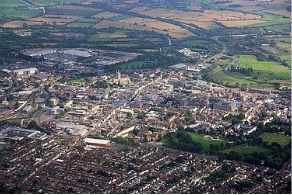
II. Natural Geography (environment and resources)
Climate
Gloucester is the county town of Gloucestershire, and is the 53rd largest settlement in the United Kingdom by population. In 2002, its population was 110,600. It has the traditional lowest bridging point of the longest river in Great Britain, connecting it with Over. The 2011 census recorded that the city had a population of 121,921 and by 2016 its population was estimated to be 128,488. The city's urban area extends beyond its boundaries, with several outlying districts. The 2011 census gave the population of the Gloucester Urban Area as 150,053, absorbing areas such as Brockworth and Churchdown.
Road
The M5 motorway, opened in 1971 runs east of the city bounds. Junction 12 serves south Gloucester and Quedgeley. Junction 11a serves central Gloucester and junction 11 serves north Gloucester. The A38 runs north–south through Gloucester connecting the city with Tewkesbury and Bristol. The A40 runs west to east, connecting Gloucester with Cheltenham to the east (via a dual carriageway section known as The Golden Valley Bypass) and the Forest of Dean, Monmouth and Swansea to the West. The A46 and A4173 links Stroud, and the A417 links Cirencester in the south east and Ledbury in the north west. Gloucester has a network of cycle paths.
Bridge
Until the construction of the Severn Bridge in 1966, Gloucester was the lowest road bridging point on the river and hence was an important settlement between South Wales and the southernmost counties of England including London. The Severn has a small anabranch here to reach Alney Island and then the main western bank. A bridge at Over, built by Thomas Telford in 1829, still stands, notable for its very flat arch, but its fragility and narrowness means it is disused, and since 1974 it has been paralleled by a modern bridge. The Gloucester to Newport Line railway bridge is close to both, the lowest crossing of the UK's longest river until the Severn Railway Bridge 1879–1970, which was coupled with the Severn Tunnel in 1886, the present holder of that status.
Rail
Gloucester railway station has frequent trains to London Paddington via Reading, Bristol, Cardiff Central, Nottingham and Birmingham. Gloucester was the site of the Gloucester Railway Carriage and Wagon Company railway works, which have now closed. A Hunts Grove railway station has been floated on the southern edge of the city near Quedgeley as part of MetroWest plans to extend Bristol commuter services to the city.
Air
Commercial airports with scheduled services are Bristol and Cardiff International Airport 40–60 miles away; global hub Heathrow is about 100 miles by road and shares with Gloucester its main rail interchange at London Paddington. Gloucestershire Airport 8 miles east is a private and special charters airfield.
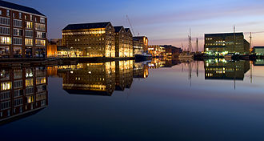
III.ECONOMY
£15.1billion
It is estimated that the gross domestic product (GDP) of Gloucestershire, the market value of all final goods and services produced in the area, is a whopping £15.1billion in 2017. It is the standard figure to show the strength of a region, or country's, economy.
Reference Website:
https://www.gloucestershirelive.co.uk/news/gloucester-news/how-much-gloucestershire-worth-what-617572
IV. Industrial Characterisitics
Major industries:
In the Middle Ages the main export was wool, which came from the Cotswolds and was processed in Gloucester; other exports included leather and iron (tools and weapons). Gloucester also had a large fishing industry at that time.
Gloucester has a long history in the aerospace business. In 1926 the Gloucestershire Aircraft Company at Brockworth changed its name to the Gloster Aircraft Company because international customers claimed that the name "Gloucestershire" was too difficult to spell. A sculpture in the city centre celebrates Gloucester's aviation history and its involvement in the jet engine. Frank Whittle's pioneering turbojet engine powered the Gloster E.28/39, the first British jet aircraft, which first flew at the company's airfield at Brockworth. This is commemorated by the pub "The Whittle" at Gloucester Business Park, which now occupies the site. Roads in the business park are named after other Gloster aircraft and a small statue overlooks the site of the old main runway. Messier-Dowty's landing gear plant and GE Aviation Dowty Propellers plants are on the outskirts of the city.
The large insurer Ecclesiastical Insurance is based in the city, as is its owner, the charity Allchurches Trust. Lloyds Banking Group and TSB Bank each have an office in Barnwood, the former previously having been the headquarters of Cheltenham & Gloucester Building Society. Gloucester was the home of Priday, Metford and Company Limited, a family milling firm which survived for over one hundred years, and hydraulic engineering firm Fielding & Platt. Gloucester Business Park is a business park on the outskirts on the city and is home to a number of big brands including Fortis and BAE Systems Applied Intelligence
Major projects and related introductions:
A419 Highway Improvements
The scheme comprises of a package of junction improvements and carriageway widening along the A419, with the key locations and proposed improvements identified below: Construction started in March 2019 at the Chipmans Platt Roundabout and works at the other sites will follow sequentially West to East along the corridor until Spring 2020.
V. Attractions
1. Gloucester Cathedral:
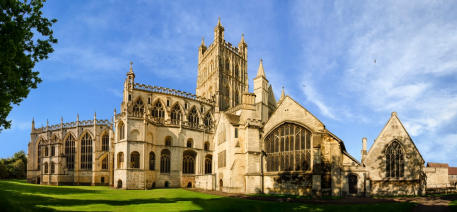
The cathedral as we see it was completed between the 11th and 15th century and has a Norman Romanesque core, and embellishments from every phase of English Gothic architecture. From a distance you can’t help but be drawn to the 15th-century Perpendicular tower, which is 69 metres high and topped with four intricate pinnacles.
2. Gloucester Docks:
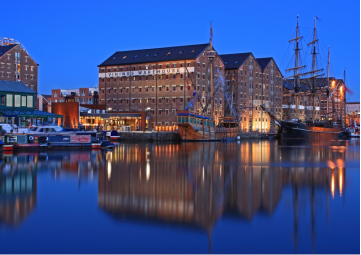
Gloucester has England’s most inland port, which came about in the first decades of the 19th century when the Gloucester and Sharpness Canal was completed. With the advent of railways and road freight the docks fell into disuse in the 20th century, before being revived as a stylish residential and commercial area in the 1980s.
3. Gloucester and Sharpness Canal:
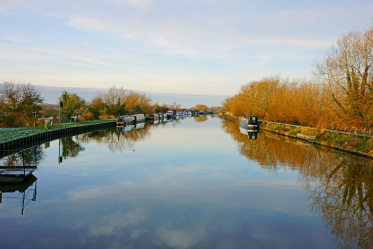
When it was completed it was the broadest and the deepest canal in the world, allowing far larger ships to visit Gloucester’s docks than had been possible on this difficult stretch of the river. The large span of the canal is crossed by bulky swing bridges, beside dainty bridge-keepers’ houses, which lend the canal a distinctive character.
Reference Website:
https://www.thecrazytourist.com/15-best-things-to-do-in-gloucester-gloucestershire-england/
VI. History
Etymology
Anglo-Saxon migrants followed by their fledgling feudal structure, the Kingdom of Wessex, overturned and culturally overwhelmed the area's Romano-Celtic society and gradually Anglicised similar spoken forms to Caerloyw, Gloucester's name in modern Welsh. They likewise tended to credit the Roman fortification for which they would use any variants of the term -cester/chester/caster (cf. Dorset and Exeter) instead of the Welsh caer. Caerloyw is: caer (meaning "fort, stronghold or castle") and loyw, a lenition of gloyw as it would have therefore early been pronounced among many speakers, means "bright/shiny/glowy". The name Gloucester thus means roughly "bright fort". Medieval orthographies include Caer Glow, Gleawecastre and Gleucestre. Pre-Roman British settlement is not confirmed by direct evidence.
Celts and Saxons
Withdrawal of all Roman forces and many societal leaders completed in about the year 410 and leading families of the Dobunni tribe may have regained power within the now Roman-influenced, interconnected and intermixed Celtic Brythonic local people. This intermix is reflected by the fact a large minority of basic words and available synonyms in Welsh have a Latin base. In the Anglo-Saxon Chronicle Gloucester is shown as part of Wessex from the Battle of Deorham in 577. At some point afterwards, along with the rest of its shire excluding the Forest of Dean, Gloucester was part of the minor kingdom of the Hwicce. In 628, as a result of the Battle of Cirencester, that kingdom became a client or sub-kingdom of Mercia.
Normans
After the Norman Conquest, William Rufus made Robert Fitzhamon the first baron or overlord of Gloucester. Fitzhamon had a military base at Cardiff Castle, and for the succeeding years the history of Gloucester was closely linked to that of Cardiff.
Modern era
Gloucester was incorporated by King Richard III in 1483, the town being made a county in itself. This charter was confirmed in 1489 and 1510, and other charters of incorporation were received by Gloucester from Queen Elizabeth I and King James I. Gloucester was the site of the execution by burning of John Hooper, Bishop of Gloucester, in the time of Queen Mary in 1555. In 1580, Gloucester was awarded the status of a port by Queen Elizabeth I. The Siege of Gloucester in 1643 was a battle of the English Civil War in which the besieged parliamentarians emerged victorious.
VII. Culture
The Three Choirs Festival, originating in the 18th century and one of the oldest music festivals in the British Isles, is held in Gloucester every third year, the other venues being Hereford and Worcester. Gloucester hosted the festival in 2019, and it is next due in the city in 2023.
The city's main theatre and cultural venue is the Guildhall. The Guildhall hosts a huge amount of entertainment, including live music, dance sessions, a cinema, bar, café, art gallery and much more. The Leisure Centre, GL1, hosts concerts and has a larger capacity than the Guildhall.
The annual Gloucester International Rhythm and Blues Festival takes place at the end of July and early August. Gloucester International Cajun and Zydeco Festival, the largest in the UK and longest-running in Europe, runs for a weekend in January each year. A Medieval Fayre is held in Westgate Street each year during the summer.
Gloucester is also noted as the home of the Frightmare Halloween Festival, the largest Halloween festival in the South West.
The main museum in the city is The Museum of Gloucester but there are several other important museums.
The Tailor of Gloucester House which is dedicated to the author Beatrix Potter can be found near the cathedral.
Since 2013 Gloucester has marked Armed Forces Day with a Drum Head Service held on College Green in the shadow of the cathedral. This is followed by a parade of serving forces, veterans and cadets through the city centre to the docks for a family day with military and military-related charity displays and entertainment in Back Badge Square in front of the Soldiers of Gloucestershire Museum.
Nature in Art is a gallery dedicated to the display of works of art inspired by the natural world.
The city features in the popular, well-known nursery rhyme (of unknown date and origin) about a Doctor Foster, who reportedly visited the city, got wet, and swore to stay away as a result.
VIII. Other information
Gloucester has many churches, and historically has also had many dissenting chapels. It may have been the old proverb "as sure as God's in Gloucester" that provoked Oliver Cromwell to declare that the city had "more churches than godliness". Gloucester was the host of the first Sunday school in England; this was founded by Robert Raikes in 1780. Four of the churches that are of special interest are
·St Mary de Lode – with a Norman tower and chancel, and a monument of Bishop John Hooper. It was built on the site of an ancient Roman temple which became the first Christian church in Britain
·St Mary de Crypt – with a cruciform structure of the 12th century. It has later additions, such as the tower. Also the site of the Schoolroom in which the Crypt School was formed
·St Michael's Church – said to have been connected with St Peter's ancient abbey
·St Nicholas's Church – founded by the Normans but with many additions since then.
In the neighbourhood around St Mary de Crypt there are slight remains of Greyfriars and Blackfriars monasteries, and also of the city wall. Under the Golden Fleece (The Monks Bar) and Saracen's Head inns early vaulted cellars still remains. In addition, in the city is St Peter's Roman Catholic Church, a Grade II* listed building
During the construction of the Boots store on the corner of Brunswick Road and Eastgate Street in 1974, Roman remains were found. These can be seen through a glass case on the street. At the back of the Gloucester Furniture Exhibition Centre part of the city's South Gate can be seen.
IX. Contact information
Mayor/Officer: Kate Haigh
Tel: 01452 425000
Mail: customerservices@gloucestershire.gov.uk
Reference Website:
https://www.gloucestershire.gov.uk/contact-us/
https://www.gloucestershirelive.co.uk/news/gloucester-news/mayor-sheriff-gloucester-elected-virtually-4183078
